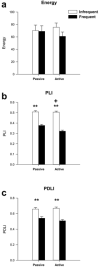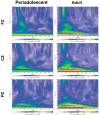Decreases in energy and increases in phase locking of event-related oscillations to auditory stimuli occur during adolescence in human and rodent brain
- PMID: 24819672
- PMCID: PMC4125510
- DOI: 10.1159/000358484
Decreases in energy and increases in phase locking of event-related oscillations to auditory stimuli occur during adolescence in human and rodent brain
Abstract
Synchrony of phase (phase locking) of event-related oscillations (EROs) within and between different brain areas has been suggested to reflect communication exchange between neural networks and as such may be a sensitive and translational measure of changes in brain remodeling that occur during adolescence. This study sought to investigate developmental changes in EROs using a similar auditory event-related potential (ERP) paradigm in both rats and humans. Energy and phase variability of EROs collected from 38 young adult men (aged 18-25 years), 33 periadolescent boys (aged 10-14 years), 15 male periadolescent rats [at postnatal day (PD) 36] and 19 male adult rats (at PD103) were investigated. Three channels of ERP data (frontal cortex, central cortex and parietal cortex) were collected from the humans using an 'oddball plus noise' paradigm that was presented under passive (no behavioral response required) conditions in the periadolescents and under active conditions (where each subject was instructed to depress a counter each time he detected an infrequent target tone) in adults and adolescents. ERPs were recorded in rats using only the passive paradigm. In order to compare the tasks used in rats to those used in humans, we first studied whether three ERO measures [energy, phase locking index (PLI) within an electrode site and phase difference locking index (PDLI) between different electrode sites] differentiated the 'active' from 'passive' ERP tasks. Secondly, we explored our main question of whether the three ERO measures differentiated adults from periadolescents in a similar manner in both humans and rats. No significant changes were found in measures of ERO energy between the active and passive tasks in the periadolescent human participants. There was a smaller but significant increase in PLI but not PDLI as a function of active task requirements. Developmental differences were found in energy, PLI and PDLI values between the periadolescents and adults in both the rats and the human participants. Neuronal synchrony as indexed by PLI and PDLI was significantly higher to the infrequent (target) tone compared to the frequent (nontarget) tone in all brain sites in all of the regions of interest time-frequency intervals. Significantly higher ERO energy and significantly lower synchrony was seen in the periadolescent humans and rats compared to their adult counterparts. Taken together these findings are consistent with the hypothesis that adolescent remodeling of the brain includes decreases in energy and increases in synchrony over a wide frequency range both within and between neuronal networks and that these effects are conserved over evolution.
© 2014 S. Karger AG, Basel.
Figures








Similar articles
-
Event-related oscillations (ERO) during an active discrimination task: Effects of lesions of the nucleus basalis magnocellularis.Int J Psychophysiol. 2016 May;103:53-61. doi: 10.1016/j.ijpsycho.2015.02.010. Epub 2015 Feb 7. Int J Psychophysiol. 2016. PMID: 25660307 Free PMC article.
-
Phase locking of event-related oscillations is decreased in both young adult humans and rats with a history of adolescent alcohol exposure.Addict Biol. 2020 Mar;25(2):e12732. doi: 10.1111/adb.12732. Epub 2019 Mar 18. Addict Biol. 2020. PMID: 30884076 Free PMC article.
-
Cholinergic modulation of event-related oscillations (ERO).Brain Res. 2014 Apr 22;1559:11-25. doi: 10.1016/j.brainres.2014.02.043. Epub 2014 Mar 2. Brain Res. 2014. PMID: 24594019 Free PMC article.
-
Ethanol reduces the phase locking of neural activity in human and rodent brain.Brain Res. 2012 Apr 23;1450:67-79. doi: 10.1016/j.brainres.2012.02.039. Epub 2012 Feb 22. Brain Res. 2012. PMID: 22410292 Free PMC article.
-
Acute low-level alcohol consumption reduces phase locking of event-related oscillations in rodents.Behav Brain Res. 2017 Jul 14;330:25-29. doi: 10.1016/j.bbr.2017.05.007. Epub 2017 May 8. Behav Brain Res. 2017. PMID: 28495609 Free PMC article.
Cited by
-
Event-related oscillations (ERO) during an active discrimination task: Effects of lesions of the nucleus basalis magnocellularis.Int J Psychophysiol. 2016 May;103:53-61. doi: 10.1016/j.ijpsycho.2015.02.010. Epub 2015 Feb 7. Int J Psychophysiol. 2016. PMID: 25660307 Free PMC article.
-
Developmental changes in spontaneous electrocortical activity and network organization from early to late childhood.Neuroimage. 2015 Sep;118:237-47. doi: 10.1016/j.neuroimage.2015.06.013. Epub 2015 Jun 7. Neuroimage. 2015. PMID: 26057595 Free PMC article.
-
Phase locking of event-related oscillations is decreased in both young adult humans and rats with a history of adolescent alcohol exposure.Addict Biol. 2020 Mar;25(2):e12732. doi: 10.1111/adb.12732. Epub 2019 Mar 18. Addict Biol. 2020. PMID: 30884076 Free PMC article.
-
Translating Adult Electrophysiology Findings to Younger Patient Populations: Difficulty Measuring 40-Hz Auditory Steady-State Responses in Typically Developing Children and Children with Autism Spectrum Disorder.Dev Neurosci. 2016;38(1):1-14. doi: 10.1159/000441943. Epub 2016 Jan 6. Dev Neurosci. 2016. PMID: 26730806 Free PMC article.
-
Amphetamine alters an EEG marker of reward processing in humans and mice.Psychopharmacology (Berl). 2022 Mar;239(3):923-933. doi: 10.1007/s00213-022-06082-z. Epub 2022 Feb 8. Psychopharmacology (Berl). 2022. PMID: 35132440 Free PMC article.
References
Publication types
MeSH terms
Grants and funding
LinkOut - more resources
Full Text Sources
Other Literature Sources
Miscellaneous

